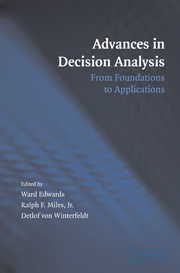Book contents
- Frontmatter
- Contents
- List of Contributors
- Preface
- 1 Introduction
- PART I HISTORY AND FOUNDATIONS OF DECISION ANALYSIS
- PART II STRUCTURING DECISION PROBLEMS
- PART III PROBABILITIES AND BAYES NETS
- PART IV UTILITIES
- PART V RISK ANALYSIS
- PART VI DECISION ANALYSIS IN A BEHAVIORAL AND ORGANIZATIONAL CONTEXT
- 18 What Have We Learned from Our Mistakes?
- 19 Decision Conferencing
- 20 Resource Allocation Decisions
- 21 From Decision Analysis to the Decision Organization
- 22 Building Decision Competency in Organizations
- 23 Negotiation Analysis: Between Decisions and Games
- PART VII APPLICATIONS OF DECISION ANALYSIS
- Index
22 - Building Decision Competency in Organizations
Published online by Cambridge University Press: 05 June 2012
- Frontmatter
- Contents
- List of Contributors
- Preface
- 1 Introduction
- PART I HISTORY AND FOUNDATIONS OF DECISION ANALYSIS
- PART II STRUCTURING DECISION PROBLEMS
- PART III PROBABILITIES AND BAYES NETS
- PART IV UTILITIES
- PART V RISK ANALYSIS
- PART VI DECISION ANALYSIS IN A BEHAVIORAL AND ORGANIZATIONAL CONTEXT
- 18 What Have We Learned from Our Mistakes?
- 19 Decision Conferencing
- 20 Resource Allocation Decisions
- 21 From Decision Analysis to the Decision Organization
- 22 Building Decision Competency in Organizations
- 23 Negotiation Analysis: Between Decisions and Games
- PART VII APPLICATIONS OF DECISION ANALYSIS
- Index
Summary
ABSTRACT. Decision analysis was introduced about 40 years ago. Since that time the practice of decision consultants, whether internal or external to organizations, has expanded from analytical support in difficult decisions to designing governance and decision systems and transforming enterprise capabilities. Organizations realize a significant positive impact when they develop true decision competency – that is, when high-quality decision making becomes part of their organizational DNA. In this chapter, the author first defines organizational decision competency and then describes how to achieve this competency. He describes two cases of two large corporations that have achieved a high level of decision competency. He concludes with a perspective on the first 40 years of corporate adoption of decision competencies that still has a long way to go.
Background
In the mid-1960s, Ronald Howard and James Matheson formed the Decision Analysis Group at Stanford Research Institute with the vision of creating a “teaching hospital” for decision analysis, a then-emerging discipline. Their goal was to advance the practice of decision analysis and build professional competency in the discipline among SRI's clients. Initially, decision analysis practitioners used a systems engineering approach based on normative decision science to identify the optimal choice among a set of alternatives in the light of real-world uncertainty, dynamics, and complexity. As the discipline evolved, it incorporated various methods from the behavioral decision sciences to deal with biases and to obtain organizational alignment with commitment to effective action.
- Type
- Chapter
- Information
- Advances in Decision AnalysisFrom Foundations to Applications, pp. 451 - 468Publisher: Cambridge University PressPrint publication year: 2007
- 12
- Cited by



